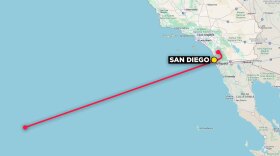With wildfire danger peaking, California's fleet of 22 air tankers was cleared Friday to return to the skies after investigators found no evidence that a fatal crash of one of the tankers earlier in the week was the result of faulty equipment.
The return of the workhorse twin-engine S-2T airplanes came as firefighters were battling blazes east of Sacramento and at Yosemite National Park, where a veteran pilot was killed Tuesday when his air tanker crashed.
None of the reactivated air tankers was immediately dispatched to the fire along Interstate 80 about 40 miles northeast of Sacramento, and the aircraft likely won't be dispatched to the Yosemite blaze, Cal Fire spokesman Daniel Berlant said.
Still, officials said it was good to have them back during the fire season that has been extended by drought and unseasonably hot, dry weather.
"Obviously, it's critical for us to get these (planes) back up in the air," Cal Fire Director Ken Pimlott said.
The state was fortunate that air tankers under contract to the federal government were able to step in to fill the gap because few fires were burning elsewhere in the nation, he said.
Cal Fire lifted the safety stand-down for the state airplanes after federal investigators found the tanker crash did not involve structural failure or aging aircraft issues, Pimlott said.
The planes were grounded after pilot Geoffrey "Craig" Hunt died when his plane smashed into a steep canyon wall while dropping retardant on a fire near Yosemite's west entrance.
Hunt was making his second drop of the day and did not make any radio calls before the crash, said Josh Cawthra, an aviation accident investigator with the National Transportation Safety Board.
"We are comfortable to say at this point we do not see anything that leads us to any mechanical-related issues with the accident sequence," he said.
The crash investigation will take months, but at least initially there were no indications of turbulence and visibility was good at the time of the crash, Cawthra said.
Preliminary indications are that the left wing struck something and came off the airplane, officials said. The finding won't be certain until investigators find paint transfer or other evidence of the wing's initial impact, Cal Fire's chief pilot Bill Payne said.
Hunt, 62, of San Jose was a 13-year veteran pilot of DynCorp International. Like the other pilots, he flew the air tanker under a contract with the state.
Berlant said none of the reactivated tankers was immediately called up to the fire northeast of Sacramento because of minimal fire activity.
The blaze was threatening 1,000 structures — many of the homes under mandatory evacuation orders — around the Placer County community of Applegate. It was holding steady at 420 acres with containment at 30 percent.
The fire in Yosemite National Park, meanwhile, was at 311 acres and 25 percent contained. A major route into the park remained closed, and there were power outages in Yosemite Valley.







